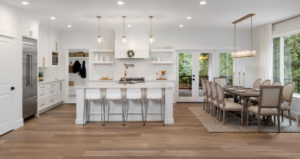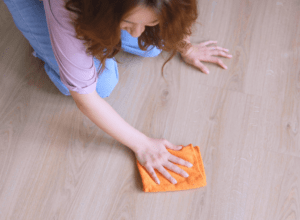

30 Apr What is Laminate Flooring?
Laminate flooring was first introduced by a Swedish company as a method of reusing waste wood for economical and ethical reasons. Buyers were found to favour its significantly cheaper price while being able to retain an authentic look, just like a real hardwood flooring.
This guide will provide you all the pros and cons about laminate flooring so you can decide whether or not it’s for you.
What is Laminate Flooring Made Of?
Laminate flooring is first created by deconstructing wood to make it into a pulp, and then fusing them together in order to create a synthetic core. The three primary layers are:
- Wear Layer – A thin layer (Usually 0.5mm) constructed mainly of aluminium oxide coating on top of the plank. It provides UV protection, scratch resistance, as well as moisture resistance.
- Print Layer – Advances in embossing technology allows us to replicate the texture and features of real timber. At FloorVenue, we stock over hundreds of different designs, so you’ll certainly be spoilt for choice!
- HDF Core – The distinguishing layer is made up of recycled wood chips and general timber waste, the end product being high density fibreboards, providing a stable base to build upon.
Lastly, laminate flooring are floating floors which feature a click-lock system. It relies on gravity and friction to hold them in place which makes these planks easy to install without the need for smelly adhesives or glue.
Below are some popular colours chosen by our customers. Notice that they are almost indistinguishable from real timber flooring, thanks to improvements in print and embossing technology. You can browse our full laminate flooring range here.
| Blackbutt | Oak Grey | Oak Natural | Spotted Gum |
  |
  |
  |
  |
Pros and Cons of Laminate Flooring
Advantages of Laminate Floors
Reasons for choosing laminate flooring go beyond saving a few dollars. Laminate floorboards have a number of advantages to make sure you get bang for your buck. These include:
- Durability – Laminate flooring is very durable, known for it’s very high scratch and dent resistance. It is even more abrasion resistant than the strongest hardwood species, making it perfect for high traffic areas.
- Laminate floors are economical – As one of the lowest priced flooring options, laminate flooring can accomodate for even the tightest budgets at $20-$50/sqm. Bring the authentic timber look into your home for half the price!
- Laminate floors are easy to install – Laminate flooring has a simple click-lock system which makes the installation process efficient and effortless, without the need for adhesives or glue.
- Water resistant – Laminate flooring can be water resistant, which provides protection against accidental spills as well as helping your peace of mind.
- Variety – Experience a seemingly endless choice of colours and styles to suit your taste. Whether you want to replicate an authentic, natural timber appearance or create your own unique design, with laminate flooring there is something for everyone.
- Low maintenance – Laminate flooring offers moisture and stain resistant surfaces to make spills and messes easy to clean up and handle.
Disadvantages of Laminate Floors
Even with all its benefits, there are some things you need to consider before buying laminate floors. These include:
- Laminate floors fear water – Although there are water resistant laminate ranges, they are still made up of wood, and will be susceptible to water damage if left in moist environments for extended periods of time. Laminate flooring is not recommended for kitchens or laundries.
- Laminate floors may be unreliable – These planks can have a large variance in quality. Be careful of very cheap laminate floors, some are poorly made, affecting durability and potentially offsetting savings made when buying this floor in repair costs. Cheaper floors may also have repetitive patterns giving it a fake and artificial look.
- Laminate floors aren’t real timber – Although it may look exactly like real oak floors, there are bound to be discrepancies in the feel. Many prefer the natural feel of solid timber underfoot rather than a manufactured version.
Which Areas are Laminate Floorboards Suitable For?
Laminate flooring is hardwearing and sometimes water resistant, which makes it a versatile choice and will be a great flooring for your home, as well as in commercial areas. Furthermore, its floating floor capabilities allow for an easy and quiet installation process. This is especially perfect for people living or working in high rise complexes who have to be considerate of their neighbours in regards to noise level, particularly in buildings with strict strata policies. Best of all, laminate flooring provides a vast range of designs to suit your taste. Whether the aim is a professional and serious tone or a bright, unique statement, laminate flooring has it all.
We have a definitive guide to laminate flooring – definitely a great read if you are deciding whether or not its the best for you!


How to Clean and Maintain Laminate Flooring
The most important thing to keep in mind when cleaning laminate flooring is to use tools that are not abrasive. One clean every week should be sufficient to keep your floor looking brand new. Mopping, vacuuming and sweeping are all great methods to cleaning laminate flooring. Here are some quick tips for cleaning and maintaining laminate flooring, so you can keep them beautiful for many years to come:
- Felt Padding – Laminate floors are very strong, but heavy furniture can still scratch the surface if moved without care. The easiest may to remove this risk is by applying felt padding to furniture legs.
- Rinse The Mop – Since the vast majority of laminate floorboards are not waterproof, it is important to avoid using excess water when mopping. Rinsing the mop will help reduce the risk of flooding the floors.
- Trim Pet Nails – If you have pets which love to play around, it is advisable to regularly trim your pets’ nails to minimise the amount of scratch accumulation.
If you want to learn more, we have an entire guide on how to clean laminate flooring.






























